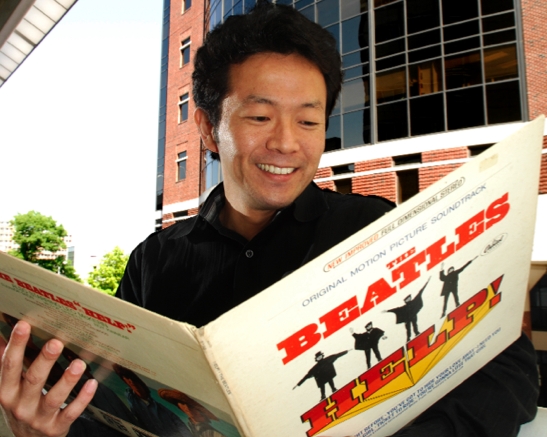Tatsuki Koyama, Ph.D., is a cancer biostatistician who grew up in Japan in a
home with the music of the Beatles all around, thanks to his Beatlemaniac
mother.
Now the Vanderbilt-Ingram Cancer Center researcher has turned that inherited
love of the Beatles into a research poster that, he says with a rueful laugh, “May be the most influential thing I’ve ever done here.
“As statisticians, we think about data display much more than laypeople would
imagine,” he adds.
Take a look at Koyama’s professional Web site, and he lists his research interests as “group sequential methods,” “two-stage adaptive procedures,” and “noninferiority/superiority/equivalence trials,” which, even if you understood what any of that means, seems a long way from his
poster at the same site titled simply “Lengths of the Beatles’ Songs.”
But he says he had a serious point to make with his analysis. The average length
of a typical Beatle song didn’t change much over the group’s eight-year recording career, but the longest and shortest songs began to range
greatly. Koyama the statistician sees this as an easy way to show the weakness
in describing things in averages. And as a Beatles fan, he knew that even
though the average song length was about the same, the effect was vastly
different between the early and late recordings.
“The average doesn’t tell the whole story,” he summarizes.
Beatles fans sort of know this: the early songs the group recorded were almost
all in the two-to-three minute range, while later albums by the Beatles tended
to have songs that were longer, but also songs that were shorter.
Case in point: the final album the group recorded, ”Abbey Road,” had one of their longest songs, “I Want You (She’s So Heavy)” (7:47), and also the shortest, “Her Majesty” (23 seconds).
Most of us, if we thought of any of this at all, would not dwell on it.
Koyama, it is fair to say, has dwelled on it.
In fact, Koyama’s poster features an amazingly detailed representation of almost every song the Beatles recorded, plotted by song length and release date.
Koyama is justifiably proud of the poster’s design, which manages to plot 211 songs grouped by album; songwriter; release
date; and song length, and to present all of that information on a single grid.
Even before he became a statistical chronicler of Beatles songs, Koyama’s life story is entwined with the music of the Beatles. He was born in 1974,
four years after the group disbanded, yet he recalls growing up in a house full
of Beatles music.
“I’m not of the Beatles’ era, but they may be why I’m here,” he says, of his decision to build his career in the United States. “I got interested in Western culture through the Beatles. For a long time, I
thought they were American,” he says with a laugh. “My first exposure to English and Western culture was the Beatles.”
He first came to the U.S. at the age of 17 as a high school exchange student,
and stayed for undergraduate school at the University of California at
Berkeley, followed by graduate school at the University of Pittsburgh, where he
received his doctorate in statistics in 2003, and came to Vanderbilt shortly
afterward.
It was during his time in graduate school that the idea came to him about the
varying lengths of Beatles songs, based on his observation that the purchaser
of one of their early albums, such as “Please Please Me,” would get only about 30 minutes of music.
But despite the brevity of those early albums, Koyama says in general he prefers
the early Beatles to the group’s later efforts.
When asked which is his favorite album, he sits back at his office desk in the
Preston Research Building for a moment and gets a faraway look in his eyes.
“Oh, that’s a difficult question,” he says. He finally settles on one: “’Help!’ he says. “’Help!’ has good songs.”
Koyama has two sons, 4-year-old Taiga and 21-month-old Keigo, and he says that,
so far, they are not following in their father’s footsteps as Beatles fans. Right now they’re more into Jimi Hendrix, and, especially, Chuck Berry’s “Johnny B. Goode.”
“Some parents have their babies listen to Mozart,” Koyama says with a smile. “My 4-year-old likes ‘Go, Johnny, go.’”
Click to enlarge and download



